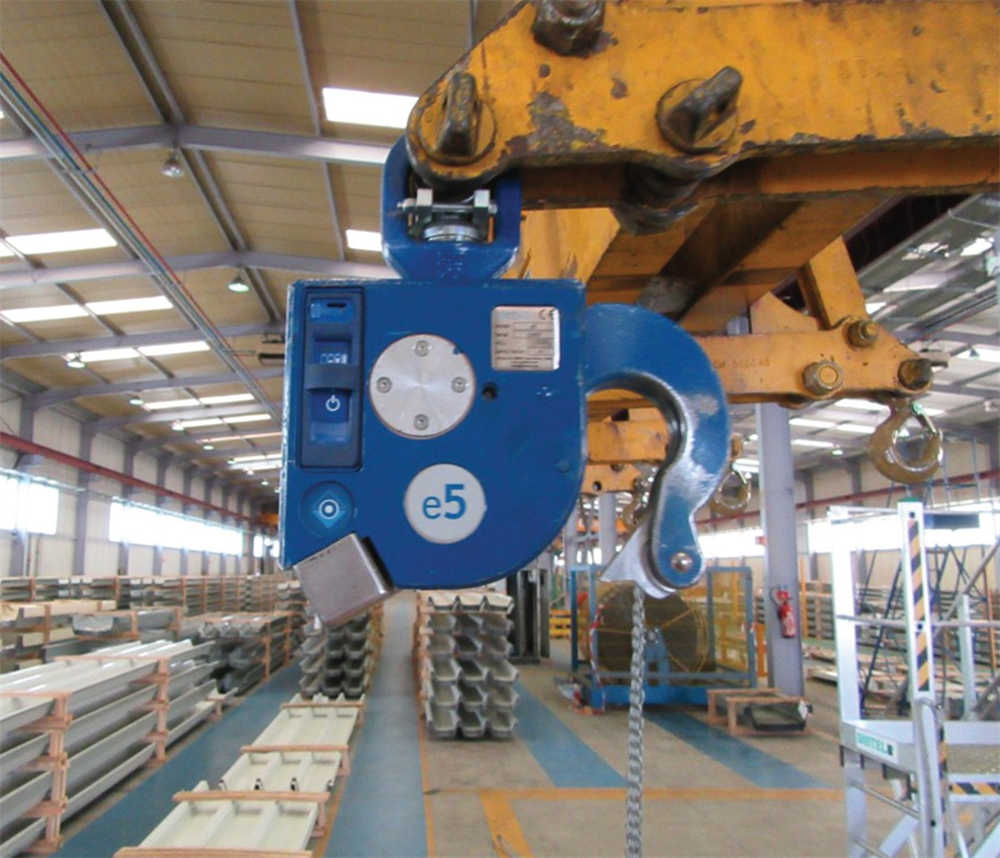Overhead cranes and automatic hooks improve safety in construction industry
Everyone knows that with the development of intelligent bridge cranes, the working environment of workers has become safer and safer, but how does this process happen? What new requirements do more reliable overhead cranes place on crane suppliers? We saw some helpful points for companies in a case of bridge cranes in the construction industry.
Overhead cranes and automatic hooks improve safety in construction industry
A global provider of building systems and materials, is using automatic hooks with overhead cranes to lift steel profiles at two sites in eastern France.
The steel and mining giant’s construction arm produces a variety of building components including roofing sheets, cladding and laminate flooring at its factories. Safety is paramount throughout the entire manufacturing and material handling process.
“My mission is to continually improve safety on site,” said the site manager. “Part of our operation involves loading steel laminations onto trucks for transportation. As part of our ongoing efforts to improve best practices, we sought a method that would eliminate the need for manual labor.” Intervention allows for a method of attaching and detaching the sling.”
They purchased mainly 5-ton hooks, but also had 10-ton and 20-ton units. Three hooks are typically located on one side of an eight-pick-point rig suspended below an overhead crane. Each magnetic hook attracts and locates a sling attached to an opposing rigging point and wraps around lashing profiles weighing between 50kg and 5 tonnes.
Most commonly, only two hooks are used at each end of the load. The center hook is an important part of the rig because it can handle smaller loads independently when only one sling is required.
In all material handling operations, Elebia hooks eliminate the need for personnel to work at height or close to the load. They don’t have to climb onto a load to prepare a lift, or onto a truck trailer to disconnect rigging equipment. For example, the hazards associated with falls or trapped hands have been eliminated from our operations and, as a result, these hooks will be installed at other locations across France.

Crane supplier’s thoughts on construction industry safety
As construction projects grow in complexity and scale, the industry continually seeks innovative solutions to enhance safety and efficiency. Overhead cranes equipped with automatic hooks have become integral in this quest. Automatic hooks offer several advancements that contribute to a safer working environment:
Enhanced Load Control
Automatic hooks enable more precise control over the loads being lifted. This reduces the risk of swinging or dropping materials, which are common hazards associated with manual hook systems.
Reduced Need for Manual Rigging
With automatic hooks, the necessity for workers to manually attach and detach loads is minimized. This not only increases safety by reducing direct contact with heavy loads but also speeds up the entire lifting process.
Increased Efficiency
Automatic hooks often come with remote control systems, allowing operators to perform lifting operations from a safe distance. This increases efficiency by reducing downtime between lifts and enabling a smooth workflow.
Reliability and Maintenance
More reliable overhead cranes with automatic hooks require less maintenance. This decreases the chances of equipment failure, which is a significant safety concern on construction sites.
High Standards for Suppliers
The push for safer and more efficient cranes creates new requirements for crane suppliers:
- Innovation in Safety Features: Suppliers must continually innovate to provide the latest safety features, such as load monitoring systems and anti-collision technology.
- Compliance with Regulations: As safety regulations are updated, suppliers must ensure that their equipment complies with the latest standards.
- Worker Training: Suppliers are also responsible for providing adequate training to workers on the operation of the new equipment.
- Quality After-Sales Support: A key requirement is the ability to provide excellent after-sales support, including maintenance services and parts replacement.
Case Studies Show Positive Impact
Real-world examples, like the implementation of bridge cranes in the construction industry, highlight the tangible benefits of improved safety through the usage of overhead cranes with automatic hooks. These case studies often show a reduction in workplace accidents and increased productivity.
By leveraging the advancements in overhead crane technology, the construction industry can continue to strive towards a safer and more efficient environment for all workers involved.
What we learned from this case
In the past 20 years, our projects in the construction industry include subway projects, road tunnel projects, cement plant material handling and equipment maintenance, etc. We know the important role of automated hooks in safety. However, our current development of hooks is not comprehensive yet. If customers have corresponding needs, we will look for help from other factories. This is not something to be embarrassed about. In the era of economic and trade globalization, cooperation and complementarity are a very cost-effective production method.
Despite this, we still need to do more research and learning on this industry, which is related to customers’ actual needs and experience. At the same time, the more we know about the construction industry, the easier it is for us to find high-quality and low-cost partners for our customers when looking for cooperative manufacturers. The work we are already doing includes equipping with a real-time monitoring and early warning system that can monitor the working status and location of equipment in real time, and promptly detect and warn potential safety hazards to prevent safety accidents. Providing high-precision hoisting capabilities can ensure accurate hoisting positioning of large equipment, prefabricated components, etc., and avoid safety accidents caused by inaccurate hoisting positioning.
If you are interested in our products, you can contact us directly. If you can provide detailed working conditions and product requirements, our engineers can maximize the effectiveness and cost-effectiveness of the final product during the design stage.
